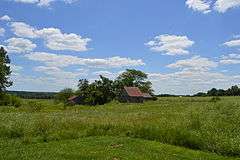New Philadelphia Town Site
|
New Philadelphia Town Site | |
|
Overview from the interpretive site | |
 | |
| Location | Pike County, Illinois |
|---|---|
| Nearest city | Barry |
| Coordinates | 39°41′45″N 90°57′35″W / 39.69583°N 90.95972°WCoordinates: 39°41′45″N 90°57′35″W / 39.69583°N 90.95972°W |
| Area | 42 acres (17 ha) |
| Built | 1869 |
| NRHP Reference # | 05000869[1] |
| Added to NRHP | August 11, 2005 |
The New Philadelphia Town Site is the original site of the now-vanished town of "New Philadelphia", Illinois. It is located near the city of Barry, in Pike County. Founded in 1836, it was the first town in the United States platted and registered by an African American before the American Civil War. The founder Free Frank McWorter was a former slave who was able to save money from work and his own business to purchase the freedom of his wife, himself and 13 members of his family in Kentucky.[2][3]
The town site was listed on the National Register of Historic Places in 2005, and designated a National Historic Landmark in 2009.[1]
History
Free Frank McWorter moved to Illinois in 1830 with his family and founded a town which he thought would benefit from the commerce along the planned Illinois and Michigan Canal. The original town plan consisted of 144 lots in a 12 x 12 square, including 22 crisscrossing named streets. McWorter officially registered his town with government authorities and sold the lots. The town was integrated, albeit with some typical 19th-century segregated facilities, such as cemeteries. There was one integrated public school.
McWorter lived there for the remainder of his life. He made brief visits to Kentucky to purchase freedom for much of the remainder of his family.[4]
McWorter died in 1854. Before the Civil War, New Philadelphia had become one of the stations along the Underground Railroad for shepherding escaped slaves to Canada. With emancipation, more settlers arrived in New Philadelphia. Its population peaked at close to 160 shortly after 1865.[4]
In 1869, the Hannibal and Naples Railroad was built. It bypassed the town on the north; a station was built in nearby Barry, soon to be followed by transit and commerce. New Philadelphia rapidly declined in population thereafter. A small number of residents turned to farming a portion of the former townsite. Such changes and abandonment were not unusual for U.S. small towns in the late 19th century, especially those bypassed by changing transportation facilities.[4]
In 1885 a portion of the town was legally dissolved. It reverted to farmland. Modern archaeological studies have indicated the area was inhabited through the 1920s. By the late 20th century, all vestiges of New Philadelphia had vanished save fragments of glass and pottery, and traces of the town's gravel streets.[4]
The town site was added to the U.S. National Register of Historic Places on August 11, 2005;[1] subsequently, New Philadelphia Town Site was designated a National Historic Landmark on January 16, 2009 because of the significance of its history and archaeology.[5]
Since 2000
In 2003, a three-year excavation began with a US$226,500 grant from the National Science Foundation. It was coordinated by Dr. Paul A. Shackel, the lead at University of Maryland, College Park, with participation by scholars from the University of Illinois, Urbana-Champaign. By 2006, the archaeology team had surveyed 14 of the 144 lots.
In August 2005, the town site was listed on the National Register of Historic Places.
In 2008, Christopher C. Fennell of the University of Illinois at Urbana-Champaign led the summer excavation team under a new grant.[6][7]
In June 2008, the Public Broadcasting Service filmed material at the dig, which was released as an episode of Time Team America.[8]
In January 2009 the town site was designated a National Historic Landmark by the Department of the Interior.
In June 2010, Aaron Schock, a US Representative from Illinois, introduced bipartisan legislation to direct the Department of Interior to study the New Philadelphia townsite for possible designation as a National Park. If approved, it would be the first such park in Illinois.[9]
On February 28, 2013, Schock introduced the legislation again (the New Philadelphia, Illinois, Study Act (H.R. 930; 113th Congress)) after its failure to become law in any previous Congress.[10]
Notes
- 1 2 3 National Park Service (2010-07-09). "National Register Information System". National Register of Historic Places. National Park Service.
- ↑ Christopher Fennell, "Historical Landscapes of New Philadelphia, Illinois", University of Illinois
- ↑ "New Philadelphia: A First," The Living Museum 71(1 & 2):9.
- 1 2 3 4 Coderno, Roberta (2003-04-17). "History in the Making". Illinois Times. Retrieved 2007-10-24.
- ↑ "KInterior Secretary Kempthorne Designates 9 National Historic Landmarks in 9 States". Department of the Interior. 2009-01-16.
- ↑ Janega, James. "Long-buried Story of Black America: Archeologists provide concrete details about African-American land speculators and utopian pioneers in the Midwest", Chicago Tribune.com, 8 Jun 2008, Retrieved 2009-06-01
- ↑ Jill (2008). "Buried Treasure: UI dig uncovers Illinois town that welcomed blacks and whites", Illinois, Vol. 21 (2), September/October 2008, Retrieved 2009-06-01
- ↑ Agbe-Davies, Anna (2009-01-12). "Searching for the African-American School House", University of Illinois, Urbana-Champaign, Retrieved on 2009-07-27
- ↑ "Schock Wants New Philadelphia Studied for National Park", The State-Journal Register, 13 Jun 2010, accessed 23 Jul 2010
- ↑ "H.R. 930 - Summary". United States Congress. Retrieved 28 April 2014.
External links
- New Philadelphia Association
- Free Frank, New Philadelphia Historic Preservation Foundation
- Christopher C. Fennell, "Updates on New Philadelphia Archaeology Project", University of Illinois, Urbana-Champaign
- "New Philadelphia: A Multiracial Town on the Illinois Frontier," Teaching with Historic Places (TwHP) lesson plan, National Park Service
- "New Philadelphia", PBS member station WILL-TV
